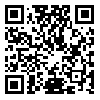Volume 16, Issue 55 (Sep 2006)
J Mazandaran Univ Med Sci 2006, 16(55): 57-64 |
Back to browse issues page
Abstract: (12370 Views)
Background and purpose: Awareness during general anesthesia is a frightening experience that often causes patients to panic and feel helpless even when there is no pain and no feel of body movement and manipulation by the surgeon.
Awareness monitoring is still complicated and controversial. Now a days this is based on electroencephalography data such as the bispectral index (BIS) or spectral edge frequency (SEF). However, there are not such divices for awareness monitoring during anesthesia at our medical centers. The postoperative interview is most frequently used for awareness monitoring. The validity of this method is questionable however, given the imperfect relation between awareness and memory.
Materials and Methods: After approval by the Mazandaran University human investigation committee, we consented and included women ASA I whom undergon caesarian section under general anesthesia. The anesthetic procedure was standardized. Anesthesia was induced with thiopentone after loss of the evelash reflex, the lungs were ventilated with 100% oxygen. Patients were interviewed 24h after operation. The principal investigators classified each patient report as awareness condition for example dreaming, feeling manipulation and etc. p<0.05 was considered as significant.
Results: One of the most common intraoperative awareness was related to hearing the sound of conversations between personnel or divices and instruments (2.8%). The most frequent condition of awareness during anesthesia was being unable to move the body (7.9%). Dreaming during general anesthesia for caesarian section was observed in 2.3% of the patients.
Conclusion: The limited use of drug during caesarian section leads to slight increase in awareness during general anesthesia. We conclude that it is important to monitor awareness during surgery. Our data showed that post operative interview is a useful method when BIS or SEF tools for monitoring of awareness during general anesthesia are not available.
Materials and Methods: After approval by the Mazandaran University human investigation committee, we consented and included women ASA I whom undergon caesarian section under general anesthesia. The anesthetic procedure was standardized. Anesthesia was induced with thiopentone after loss of the evelash reflex, the lungs were ventilated with 100% oxygen. Patients were interviewed 24h after operation. The principal investigators classified each patient report as awareness condition for example dreaming, feeling manipulation and etc. p<0.05 was considered as significant.
Results: One of the most common intraoperative awareness was related to hearing the sound of conversations between personnel or divices and instruments (2.8%). The most frequent condition of awareness during anesthesia was being unable to move the body (7.9%). Dreaming during general anesthesia for caesarian section was observed in 2.3% of the patients.
Conclusion: The limited use of drug during caesarian section leads to slight increase in awareness during general anesthesia. We conclude that it is important to monitor awareness during surgery. Our data showed that post operative interview is a useful method when BIS or SEF tools for monitoring of awareness during general anesthesia are not available.
Type of Study: Research(Original) |
| Rights and permissions | |
 |
This work is licensed under a Creative Commons Attribution-NonCommercial 4.0 International License. |


